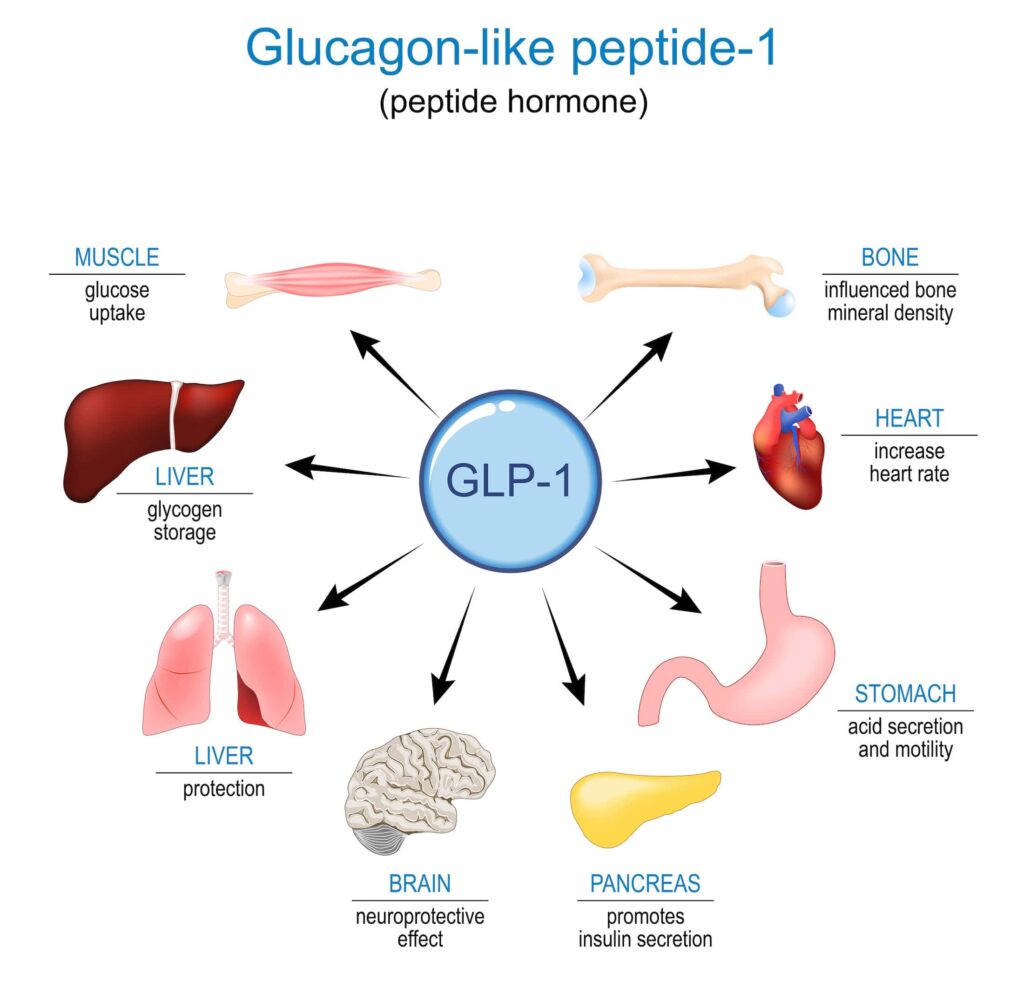You’ve probably heard about Tirzepatide—the next-generation medication that’s making headlines for its impressive weight-loss results.
What many don’t realize is that Tirzepatide is doing much MORE than slimming waistlines.
“For patients working to regain mobility, reduce inflammation, and prepare for regenerative treatments, Tirzepatide’s benefits go well beyond the scale.”
~ Dr. Ryan Wood
A Smarter Way to Support the Body
There are two types of weight-loss medications:
1. GLP-1 (glucagon-like peptide-1) medications like semaglutide trigger insulin production and slow digestion, helping people feel full longer.

2. Tirzepatide, a newer medication, targets two hormones—GLP-1 and GIP (glucose-dependent insulinotropic polypeptide)—which may lead to even more significant weight loss than GLP-1s alone.
Together, these hormones help regulate appetite, blood-sugar levels, and energy balance.
In clinical trials, patients lost 15–22% of body weight, outperforming even semaglutide. The addition of GIP seems to:
- Improve insulin sensitivity
- Reduce compensatory metabolic slowdown
- Enhance fat loss, particularly subcutaneous fat
By mimicking the natural actions of GLP-1 and GIP, Tirzepatide helps the body respond more efficiently to insulin, slows digestion, and reduces hunger—to support steady, sustainable weight loss.

How Tirzepatide May Help Protect Your Joints
Tirzepatide has gained attention for its powerful results in medical weight loss—but a growing number of studies suggest its benefits may extend beyond metabolism. Researchers are beginning to uncover an unexpected link between Tirzepatide and joint health, offering encouraging news for patients seeking relief from chronic pain and inflammation.
The Metabolic–Joint Connection
Carrying extra body weight puts significant stress on the joints, especially the knees, hips, and spine. For every pound of excess weight, the joints can experience up to four additional pounds of pressure with each step. That means even modest weight loss can dramatically reduce joint load and discomfort.

By improving insulin sensitivity and reducing systemic inflammation, Tirzepatide helps create a healthier environment for tissue repair and movement. Additionally, scientists are now seeing signs that its effects may reach even deeper than weight loss alone.
The “Good” Side Effects of Tirzepatide
As the research continues to grow, it’s becoming clear that Tirzepatide’s effects ripple through multiple systems of the body—including those tied to joint, tissue, and nerve health.
Patients often report benefits that reach far beyond what they expected:
- Better sleep and more stable energy. Improved blood-sugar regulation reduces nighttime awakenings and mid-afternoon crashes, allowing the body to recover more deeply.
- Less inflammation. Weight loss itself lowers inflammatory cytokines, but Tirzepatide also appears to reduce systemic inflammation—helping quiet the low-grade inflammation that can keep tissues from healing.
- Easier movement and less joint stress. Even a 5–10% reduction in body weight can take significant pressure off knees, hips, and ankles. For those living with chronic joint pain, every pound lost translates to less strain and better mobility.
- Improved cardiovascular and metabolic markers. Early studies suggest that Tirzepatide may enhance cholesterol and triglyceride profiles while improving insulin sensitivity—all crucial for longevity and overall vitality.
“When the body’s metabolism runs more efficiently, every system—from hormones to connective tissue—has a chance to heal.”
~ Dr. Ryan Wood
What the Research Shows
Recent population-based studies have found that individuals using Tirzepatide experience a lower risk of developing joint pain, particularly in the knees, hips, and lower back, compared to those not on the medication.
They were also less likely to rely on anti-inflammatory drugs or opioids for pain relief—suggesting real improvements in day-to-day comfort and mobility.

Another analysis compared several anti-obesity medications and discovered that people taking Tirzepatide had a significantly lower risk of osteoarthritis than those using other medications, even after accounting for factors like age and overall weight loss.
While more research is needed, the data hint at a potential protective effect on joint tissues themselves. In smaller studies, patients have reported less joint stiffness and greater ease of movement, describing the ability to walk farther, exercise more comfortably, or simply get through the day with less pain.
A Foundation for Regenerative Medicine
Think of Tirzepatide as helping your body “get into gear.” When blood sugar, hormones, and inflammation are balanced, your body becomes a more receptive environment for regenerative medicine to work. At NW Regen, many of our regenerative orthopedics patients start Tirzepatide as part of a broader strategy for whole-body healing.
For individuals who could benefit from regenerative injections such as PRP or Prolotherapy, improving metabolic health first can dramatically enhance results. Lower inflammation means better cellular communication and improved tissue repair—two critical ingredients for regenerative success.

Why This Matters for Regenerative Health
At NW Regen, we view metabolic health as the foundation for musculoskeletal recovery. Whether you’re considering PRP (platelet-rich plasma) or Prolotherapy to repair tendons and joints, lowering inflammation and improving circulation can make those treatments work even better.
Tirzepatide’s dual action on GLP-1 and GIP pathways may also help regulate inflammatory signaling throughout the body, supporting cartilage and connective tissue health from the inside out. Combined with the mechanical relief that comes from weight loss, it creates a powerful synergy for long-term joint resilience.
“When you reduce both inflammation and load on the joints,
~ Dr. Ryan Wood
the body finally gets the breathing room it needs to heal.”
The Bottom Line
Tirzepatide isn’t a shortcut—it’s a modern therapeutic tool that helps restore the body’s natural balance.
Patients often describe feeling “lighter” not just physically but mentally and energetically. While the science is still emerging, the early findings are promising: Tirzepatide may not only help people lose weight—it might also help them move better.
For those living with joint pain or considering regenerative therapy, addressing metabolic health can be the key to unlocking faster recovery and longer-lasting results.
To reduce joint pain, regain mobility, and support long-term healing, Tirzepatide may be an ideal first step.
If you’re curious about how Tirzepatide could support your mobility, energy, and overall healing, schedule a consultation with Dr. Ryan Wood to explore whether Tirzepatide could support your journey toward better movement, energy, and health.
🧠 Research References
At NW Regen, we stay current on the latest clinical studies to help our patients make informed choices. Here are a few recent findings that inspired this article:
- Tirzepatide and Joint Pain Relief A 2024 population study found that people taking Tirzepatide had a lower risk of developing joint pain—especially in the knees, hips, and lower back—and used fewer anti-inflammatory or opioid medications than those who weren’t on the treatment.
View study on ResearchGate › - Reduced Osteoarthritis Risk A large-scale analysis published in 2024 reported that patients using Tirzepatide were significantly less likely to develop osteoarthritis than those on other weight-loss medications. Read abstract on PubMed ›
- Patient-Reported Improvements in Mobility In real-world experience surveys, nearly half of participants using Tirzepatide said they could move more easily and experienced less joint stiffness or discomfort. See study summary ›
- How GLP-1 Medications May Protect Joints Research in Frontiers in Endocrinology (2022) suggests that GLP-1 receptor agonists—one of the pathways Tirzepatide targets—can reduce inflammation and slow cartilage breakdown in joint tissues Learn more ›
- Dual-Action Benefits in Preclinical Models New preclinical studies (2025) indicate that medications acting on both GLP-1 and GIP receptors may lower inflammation and protect cartilage, offering a scientific basis for Tirzepatide’s observed joint-health benefits. Explore article ›
- What Is GIP? Understanding the Hormone Transforming Weight Loss and Metabolic Research
NW Regen
We offer regenerative and interventional medicine – tailored to empower you with a more vibrant, active lifestyle.


